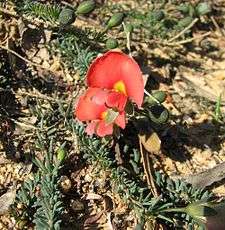Gompholobium ecostatum
| Dwarf wedge-pea | |
|---|---|
 | |
| Gompholobium ecostatum at Anglesea Heath in Victoria | |
| Scientific classification | |
| Kingdom: | Plantae |
| (unranked): | Angiosperms |
| (unranked): | Eudicots |
| (unranked): | Rosids |
| Order: | Fabales |
| Family: | Fabaceae |
| Genus: | Gompholobium |
| Species: | G. ecostatum |
| Binomial name | |
| Gompholobium ecostatum Kuchel | |
| Synonyms | |
|
Gompholobium minus var. grandiflora Benth. | |
Gompholobium ecostatum, the dwarf wedge-pea, is a small shrub which is endemic to Australia. It is a member of the family Fabaceae and of the genus Gompholobium.
The species is an erect or spreading shrub.[1] The leaves have 3 linear leaflets that are about 10 mm long and 1 mm wide.[1] The flowers, which appear in spring, are deep apricot to red, with a yellow centre.[1] The hairless pods which follow are about 8 mm long.[1]
The species was first formally described by botanist George Bentham in 1864 as Gompholobium minus var. grandiflora in Flora Australiensis.[2] It was reclassified as a species in its own right in 1965.[2]
It is found in South Australia, Victoria and on Flinders Island in Tasmania where it is listed as an endangered species.[1]
References
- 1 2 3 4 5 "Gompholobium ecostatum" (PDF). Department of Primary Industries, Water and Environment (Tasmania). Retrieved 2008-10-21.
- 1 2 "Gompholobium ecostatum". Australian Plant Name Index (APNI), IBIS database. Centre for Plant Biodiversity Research, Australian Government, Canberra. Retrieved 2008-10-21.